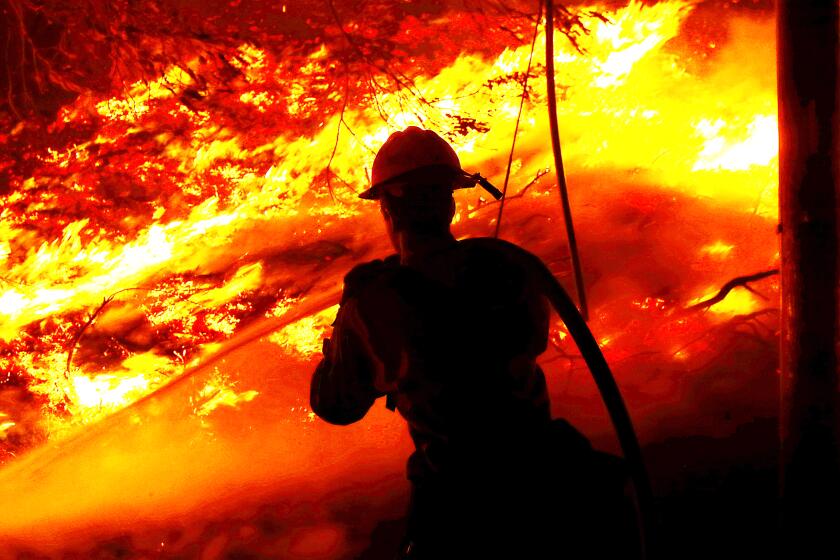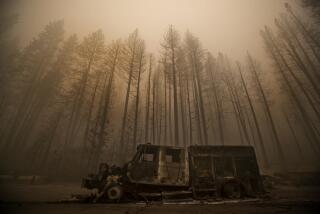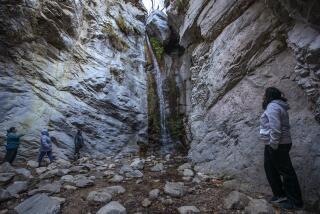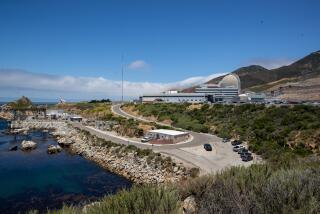Biden gives PG&E $1 billion to keep the Diablo Canyon nuclear plant open

The case for nuclear power as a climate solution got a big boost Monday, when the Biden administration announced it’s giving Pacific Gas & Electric Co. a $1.1-billion grant to help the company keep operating California’s last nuclear plant.
The Diablo Canyon plant is currently scheduled to shut down in two phases, with the first reactor going offline in 2024 and the second in 2025. But Gov. Gavin Newsom has led a spirited push to keep the reactors humming five more years, saying they’re badly needed to help the Golden State grapple with power shortages and worsening heat waves.
The federal money doesn’t guarantee Diablo Canyon will stay open longer. But it increases the likelihood of California continuing to rely on the plant, along the Central Coast in San Luis Obispo County — despite decades of anti-nuclear activism and public concerns about what would happen if an earthquake erupts along one of the seismic fault lines near the facility.
PG&E Chief Executive Patti Poppe noted that Diablo Canyon supplied more than 8% of California’s electricity last year — and 17% of the state’s climate-friendly, carbon-free electricity. She also said the plant has a strong safety record.
“It is a good choice for the state of California — and for frankly the planet — that a well-performing plant like Diablo Canyon could continue to serve,” Poppe said in an interview.
Your guide to our clean energy future
Get our Boiling Point newsletter for the latest on the power sector, water wars and more — and what they mean for California.
You may occasionally receive promotional content from the Los Angeles Times.
The $1.1 billion in federal money comes from the infrastructure law passed by Congress and signed by President Biden last year. It should allow PG&E to pay back most of the $1.4-billion loan for Diablo that state lawmakers approved at Newsom’s urging.
That state money is slated to help PG&E cover the costs of relicensing at the U.S. Nuclear Regulatory Commission, as well as maintenance, fuel purchases and additional on-site storage for radioactive waste needed to keep the plant running past 2025.
Final terms of the federal grant still need to be negotiated with PG&E. Officials at the U.S. Department of Energy say the money will be distributed over four years, from 2023 through 2026. The funds are designed to cover PG&E’s projected losses from keeping Diablo Canyon open longer, so if the company’s operating costs come in lower than expected — or its power-sales revenues are higher than expected — it won’t get quite as much federal money.
If the plant fails to secure its federal license renewal — or any of the state permits it needs to keep operating — the funding spigot will be shut off.
“This is a critical step toward ensuring that our domestic nuclear fleet will continue providing reliable and affordable power to Americans as the nation’s largest source of clean electricity,” U.S. Energy Secretary Jennifer Granholm said in a written statement.
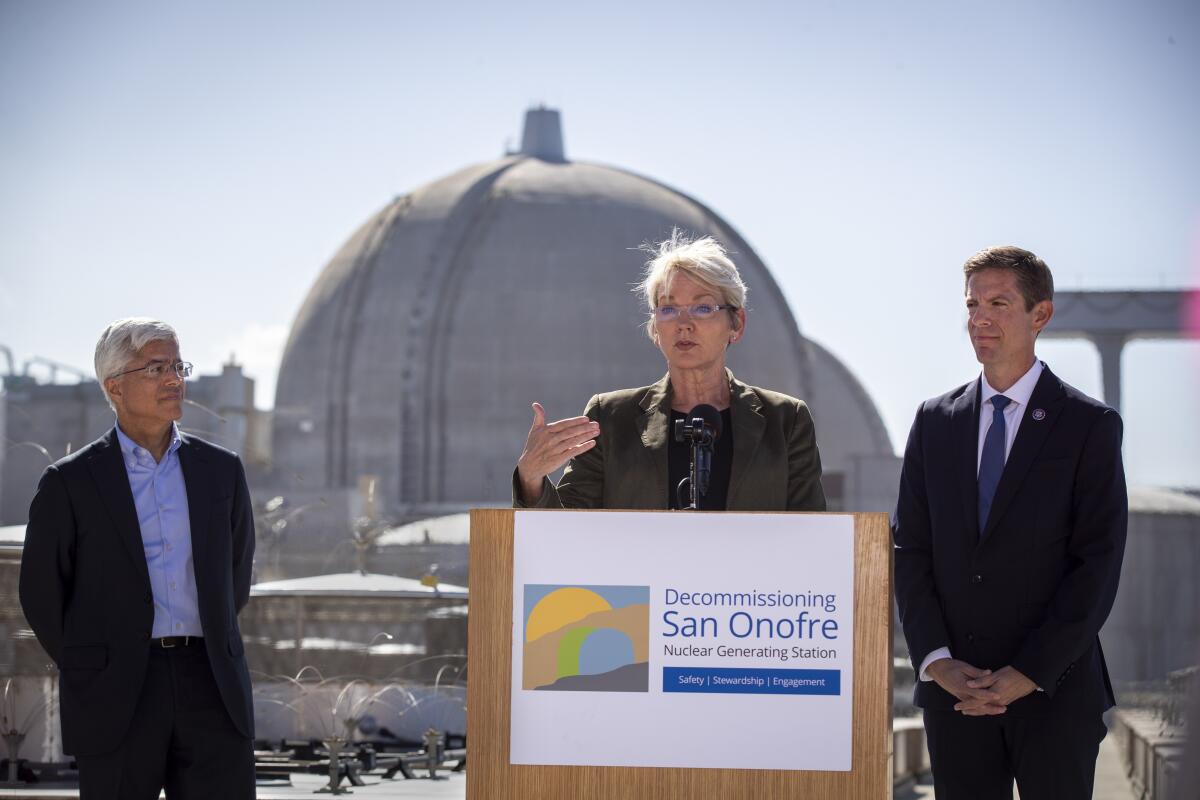
Sen. Dianne Feinstein (D-Calif.) celebrated the announcement, saying in a written statement that the federal investment “will allow Diablo Canyon to continue producing carbon-free energy until 2030, giving the state the time it needs to bring additional renewable energy sources online and eventually replace the energy produced by the nuclear plant.”
Feinstein had previously supported PG&E’s plan to shutter Diablo in 2025. But she changed her mind this year, citing the urgency of the climate crisis and the need for round-the-clock sources of clean power to complement solar and wind.
“This short-term extension is necessary if California is going to meet its ambitious clean-energy goals while continuing to deliver reliable power,” Feinstein said Monday.
Erich Pica, president of anti-nuclear environmental group Friends of the Earth, described that type of reaction to the federal funding as a “premature victory lap.” He noted that several state agencies still need to sign off on the nuclear plant’s continued operation, as spelled out in the legislation signed by Newsom.
Pica suspects the governor is motivated at least in part by political aspirations. Although Newsom has insisted he won’t run for president in 2024, speculation continues to swirl that he’s preparing for a campaign. And the current plan for Diablo to begin shutting down in 2024 “is very conspicuously aligned with when the Democratic presidential primary is going to be,” Pica said.
Newsom “doesn’t want to see any [electric grid] reliability issues come up while he’s contemplating his future political plans,” Pica said. “He’s doing that at the cost of billions of dollars to California ratepayers in maintaining Diablo.”
Wind turbines, solar panels and power lines are needed to confront climate change. But they’re also reshaping the West — and not always for the better.
The future of nuclear power has become one of America’s most contentious energy debates as the climate crisis worsens.
Nuclear disasters at Chernobyl and Three Mile Island stoked deep public fears about meltdowns and radioactive fallout, with the 2011 crisis at Japan’s Fukushima plant hardening those sentiments for many.
But worsening wildfires, heat waves, droughts and other climate extremes linked to the burning of fossil fuels — and growing awareness that nuclear plants currently produce half the nation’s carbon-free electricity — have led some to reevaluate the merits of facilities like Diablo.
A recent UC Berkeley poll co-sponsored by The Times found that 44% of California voters support building more nuclear reactors in the state, with 37% opposed and 19% undecided — a significant change from sentiment in the 1980s and 1990s. The poll found that 39% of voters oppose shutting down Diablo Canyon, 33% support closure and 28% are unsure.
Another UC Berkeley poll conducted in September found even greater support for keeping the plant running through 2030.
“I’m just happy that the tides have shifted,” Poppe told The Times.
“Only about 10% of wildfire ignitions are caused by utility equipment. And we’re going to end that,” Patti Poppe says.
The governor capitalized on those shifting tides, cajoling state lawmakers into approving a $1.4-billion loan designed to keep Diablo running through 2030. The vote came during an intense heat wave, which saw state officials beg Californians to use less power during the hot evening hours — when solar panels stop generating — for a record 10 straight days.
The state managed to avoid rolling blackouts. But it was less lucky two years earlier when a few hundred thousand homes and businesses lost power briefly over two evenings during a brutal heat wave. There was another close call in 2021, when a wildfire temporarily knocked out several key power lines that bring hydropower from the Pacific Northwest to California.
Continuing to operate Diablo Canyon is crucial for keeping the lights on while fighting climate change, supporters say. Dozens of scientists and academics have urged Newsom to keep the Diablo reactors spinning.
“Some would say it’s the righteous and right climate decision,” Newsom told The Times’ editorial board earlier this year.

The U.S. had 93 operating nuclear reactors last year, which generated nearly one-fifth of the nation’s electricity. Those plants could go a long way toward meeting President Biden’s goal of 100% climate-friendly electricity by 2035.
But 13 reactors have shut down since 2013, often due to competition from lower-cost energy sources such as solar, wind and natural gas. In some cases, nuclear closures have led to more business for gas-fired power plants, causing climate pollution to rise.
Atomic energy supporters say it’s crucial to support power plants that can generate clean electricity around the clock — hence the $6 billion set aside by Congress to rescue economically distressed facilities such as Diablo Canyon.
PG&E was the only company to receive nuclear rescue dollars Monday. At least one company was denied funding. But more money could flow to ailing nuclear plants during a second round of funding planned by the Department of Energy.
Critics see throwing money at dying nuclear plants as a dangerous, expensive solution.
Ralph Cavanagh — a top official at the nonprofit Natural Resources Defense Council and a key architect of the 2016 deal to shut down Diablo Canyon — says other clean energy technologies and strategies can keep air conditioners humming during heat waves. Rapid growth in lithium-ion batteries, for instance, played a key role in avoiding rolling blackouts this summer.
Greater funding for batteries, energy efficiency and “demand response” programs — which pay people to use less electricity when the power grid is most stressed — could negate the need for continued reliance on nuclear power, he said.
Support our journalism
Your support helps us deliver the news that matters most. Subscribe to the Los Angeles Times.
Cavanagh doesn’t put much stock in recent public polling showing growing support for California’s last nuclear plant. He noted that the most recent Berkeley poll was conducted just two weeks after the state narrowly avoided rolling blackouts.
The real question, Cavanagh said, is whether state regulators determine that extending Diablo’s life is the best solution.
“The California public is now strongly in favor of anything it thinks might shore up reliability of the Western power grid,” he said. “But the fact is, we don’t have an infinite amount of money.”
Anti-nuclear activists still hope to persuade federal officials to force Diablo Canyon’s closure in 2025.
Last week, four groups — San Luis Obispo Mothers for Peace, Environmental Working Group, Committee to Bridge the Gap and Friends of the Earth — sent a letter to the Nuclear Regulatory Commission urging the agency to deny PG&E’s request to reopen a license renewal proceeding that was dropped in 2016. PG&E should be required to submit a new application, they wrote.
Granting the company’s request would “gravely undermine key aspects of the license renewal review process that are crucial for safety,” the groups wrote.
The potential for catastrophic meltdowns — however remote — isn’t the only concern animating anti-nuclear activists. The federal government has failed to build a permanent storage facility for spent nuclear fuel, meaning radioactive waste canisters are piling up at power plants across the country — including the shuttered San Onofre plant in San Diego County.
How do the risks and harms of nuclear power compare with fossil fuels? To Poppe, the answer is clear.
“Given the significant impacts of climate change right here in California that we experience with the extreme weather, of course we would want to be able to provide the cleanest energy that is most reliable for the people of California,” she said.

